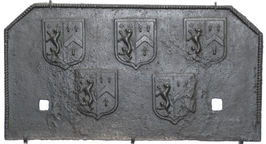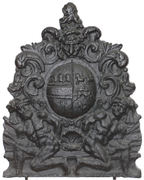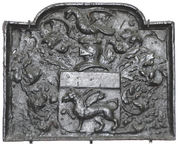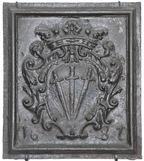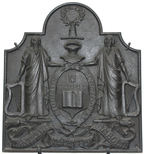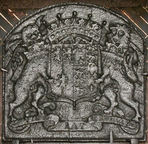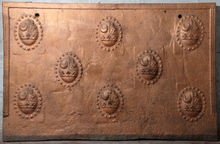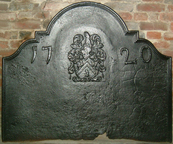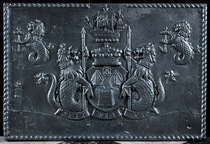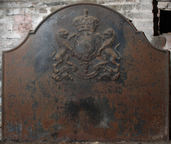-
741
Description: Rectangular, with canted top corners; twisted rope edging (top and sides only); five shields of Ayloffe impaling Sulyard in two rows, 3-2; Ayloffe: sable, a lion rampant Or, collared gules, between three crosses formy of the second; Sulyard: argent, a chevron gules between three pheons inverted sable. Two cut notches probably for firedogs.
Notes: William Ayloffe (c1535-1584) of Bretons, Hornchurch, Essex, Justice of the Court of Queen’s Bench, married (c1560) Jane, dau. of Sir Eustace Sulyard, of Runwell, Essex. A large number of variants use the same shields. The excrescences affecting the left and right sides respectively of the lower shields are the result of inexpert ladling of the iron during casting. Part of the bequest to the Victoria and Albert Museum by Lieut. Colonel G. B. Croft-Lyons in 1926.
Arms: Ayloffe impaling Sulyard (William Ayloffe of Bretons, Hornchurch)
- Decoration tags:
- rectangular with canted top corners (shape)
- rope (edging)
- carved stamps
- armorial
Manufactured: in the early-17th century in the Weald area of England.
Current location: Victoria & Albert Museum, Cromwell Road, Kensington & Chelsea, Greater London, England.
Museum number: M.621-1926 (part of the Victoria & Albert Museum museum group)
- Attached to series:
- Ayloffe series
- Personal armorial firebacks
- Andiron slot firebacks
-
757
Description: Within a surround of symmetrical swirled foliage, an oval armorial shield carried by two naked, kneeling male figures seated on a broad pedestal, between them a scallop shell; above the shield a lion’s face surmounted by a crest of a lion’s head erased. The arms are of Worge impaling Collier.
Notes: George Worge (1705-65), of Starr’s Green, Battle, steward of the Battle Abbey estate, married Elizabeth (1707-66), daughter of John Collier, town clerk of Hastings, in 1727. The arms of Worge have been variously blazoned, but the memorial to George Worge in Battle church indicates these tinctures: gules, a fess cotised or, in chief three lion’s heads erased of the last; Collier - argent, on a chevron azure, between three unicorns courant couped gules, as many oak sprigs fructed proper. This deeply detailed fireback might have been cast in a closed mould; it had a circular aperture in the centre into which, in this instance, an armorial was placed; the same armorial is on a fireback, dated 1762, at Great Dixter, Northiam, Sussex, as is the lion crest (no. 1317).
Arms: Worge impaling Collier (George and Elizabeth Worge)
- Decoration tags:
- baroque (shape)
- complex individual (edging)
- whole carved pattern
- pictorial
- armorial
- humans
Manufactured: in the early- to mid-18th century probably at Robertsbridge Furnace, Salehurst in the Weald area of England.
Current location: Victoria & Albert Museum, Cromwell Road, Kensington & Chelsea, Greater London, England.
Museum number: 686.1899 (part of the Victoria & Albert Museum museum group)
- Attached to series:
- Baroque series
- Personal armorial firebacks
- Worge/Collier series
-
758
Description: Flattened arched rectangular shape; cavetto moulded edge all round; armorial; arms of Browne family of Brenchley, Kent: Gules, a griffin passant or, a chief of the second; Crest: a vulture proper, wings endorsed, displuming a mallard’s wings.
Notes: John Browne, gunfounder, was granted arms in 1626. His principal furnace was in Brenchley parish, Kent. The royal gunfounder 1615-51, he petitioned the Crown for a monopoly of casting firebacks in 1633.
Copies of this fireback are known.
Arms: Browne of Brenchley (John Browne)
- Decoration tags:
- rectangular with round arch (shape)
- cavetto (edging)
- whole carved pattern
- armorial
Manufactured: in the early- to mid-17th century possibly at Brenchley and Horsmonden Furnace in the Weald area of England.
Current location: Victoria & Albert Museum, Cromwell Road, Kensington & Chelsea, Greater London, England.
Museum number: 493.1901 (part of the Victoria & Albert Museum museum group)
- Attached to series:
- Personal armorial firebacks
-
762
Description: Rectangular; astragal and fillet edging; oval shield of the Paulet family (sable three swords, points conjoined in pile), within a cartouche, surmounted by a marquis’s coronet; date split between bottom corners.
Notes: The arms of Charles Paulet, 6th Marquess of Winchester, who succeeded to the title in 1674 and was created Duke of Bolton in 1689. The fireback is reported to have come from Grange Farm, Basing House, Hampshire; Basing House was the seat of the Paulets.
Copies of this fireback are known.
Inscription: 16 87
Arms: Charles Paulet, 6th Marquess of Winchester
- Decoration tags:
- rectangular (shape)
- astragal & fillet (edging)
- whole carved pattern
- individual numbers
- armorial
- text
Manufactured: in 1687 possibly at Sowley Furnace, Beaulieu in England.
Current location: Victoria & Albert Museum, Cromwell Road, Kensington & Chelsea, Greater London, England.
Museum number: M.103-1913 (part of the Victoria & Albert Museum museum group)
- Attached to series:
- Personal armorial firebacks
- Paulet firebacks
-
772
Description: Cavetto canted arched rectangle; astragal edging; oval inscription surrounding a central battlemented shield bearing an open book, with a baronet's escutcheon above; above, a helm with a crest of an arm and hand holding a wreath; on each side, a druid supporter holding a harp, each upon a horizontal fillet; below, intertwined bell flowers behind a tripartite motto scroll.
Notes: The motto appears to have been incorrectly spelled; the Conroy baronetcy was created for Sir John Conroy, comptroller of the household of the Duchess of Kent, and much hated by her daughter, Princess (later Queen) Victoria; the 3rd (and last) baronet succeeded to the title in 1869.
Inscription: FIDELITER ET CONSTANTER [Faithfully and constantly] / L'ANTIQIVITE NE PEVX PAS L'ABOLIR [Antiquity cannot abolish it]
Arms: Conroy, baronet, of Llanbrynmair (Sir John Conroy, 3rd baronet, 1845-1900)
- Decoration tags:
- rectangular with canted top corners and round arch (shape)
- astragal (edging)
- whole carved pattern
- armorial
- text
- humans
Manufactured: in the late-19th century in England.
Current location: Victoria & Albert Museum, Cromwell Road, Kensington & Chelsea, Greater London, England.
Museum number: 502.1896 (part of the Victoria & Albert Museum museum group)
- Attached to series:
- Personal armorial firebacks
- Welsh armorial firebacks
-
873
Description: Arched shape; fillet edging; shield, supporters, earl's coronet and motto.
Notes: The arms are those of William Herbert (1626-96), created 1st Earl of Powis in 1674, impaled with those of his wife, Lady Elizabeth Somerset, whom he had married in 1654. He was created Marquess in 1687, so the fireback dates from between 1674 and 1687. The blazon: Party per pale azure and gules three lions rampant argent armed and langued or (Herbert), quarterly 1st and 4th England 2nd and 3rd France Modern (Somerset); Supporters: Dexter: A Panther rampant guardant Argent spotted of various colours fire issuing out of the mouth and ears ducally gorged Azure; Sinister: A Lion rampant Argent ducally gorged Gules; Motto: Ung je serviray (One I will serve).
Inscription: Ung iay serviray
Arms: William Herbert, 1st Earl of Powis
- Decoration tags:
- rounded arched (shape)
- fillet (edging)
- whole carved pattern
- armorial
- text
Manufactured: in the late-17th century .
Current location: Powis Castle, Welshpool, Powys, Wales.
Museum number: 1180869 (part of the National Trust museum group)
Citation: Anon., 1907, 'Armorial iron fire back', Montgomeryshire Collections, 34, p. 212.
- Attached to series:
- Personal armorial firebacks
- Welsh armorial firebacks
-
1043
Description: Rectangular; triple-fillet moulded edging formed of lengths of carved wood (top and upper seven-eights of sides only); stamp formed of an elliptical shield enclosed within an elliptical border of 23 beads, all mounted on a rectangular block, repeated eight times symmetrically 3-2-3.
Notes: This is a rare example of elliptical arms on a fireback; in each instance the stamp has been over-pressed so that the block on which it was carved has appeared in relief.
Arms: not known
- Decoration tags:
- rectangular (shape)
- triple-fillet moulding (edging)
- simple stamps
- carved stamps
- heraldic
- armorial
Manufactured: in the 17th century in England.
Current location: in private hands, West Hoathly, West Sussex, England.
- Attached to series:
- Personal armorial firebacks
-
787
Description: Rectangular with an arched rectangular style arch linked by symmetrical cyma curves; double moulded edges except on the base; the date, 1720, in characteristic lettering of the early 18th century, bisected by a shield and crest formed from the impression of a carved wooden stamp. The arms are probably those of a branch of the Harvey family: a chevron (gules) between three bear’s gambs erased and erect armed (ermines).
Notes: The Harvey family of Eythorne, Kent, bore similar, but not identical arms, differenced by the addition of three crescents on the chevron. There are stylistic similarities between this fireback and two firebacks bearing the arms of the Duke of Dorset at Knole, which are probably of similar date, suggesting that they could be products of the same furnace.
Inscription: 17 20
Arms: Harvey of Eythorne, Kent (variant)
- Decoration tags:
- rectangular with canted top corners and round arch (shape)
- double stepped astragal (edging)
- carved stamps
- individual numbers
- armorial
- text
Manufactured: in 1720 in the Weald area of England.
Current location: Quebec House, Westerham, Kent, England.
Museum number: 529003 (part of the National Trust museum group)
- Attached to series:
- Personal armorial firebacks
- 1720s Wealden series
-
1093
Description: Rectangular; simulated twisted rope edging with a gap, top centre; centre, shield, baron's coronet, supporters and crest; in each top corner, heraldic badge - a Sea Lion holding an anchor.
Notes: The arms are of Sir Hudson Ewbanke Kearley, Bt., 1st Baron Devonport (1856-1934); created 1910, he was elevated to Viscount in 1917, thus the fireback would have been cast between 1910 and 1917. Blazon: Azure in chief two Mitres Argent garnished Or and in base a Square Tower of the second, a baronet's badge in chief; Supporters: On either side a Sea Lion Argent crined finned and tufted Or each gorged with a Collar Gules charged with three Roses of the second and each supporting a Spear erect proper; Crest: An Ancient Ship Or the Mainsail Azure charged with a Sea Lion of the first; Motto: Fit Via Vi (The way is made through strength). A version with the same arms and badges has an arched rectangular shape and plain edging.
Inscription: FIT VIA VI
Arms: Hudson Ewbanke Kearley, 1st Baron Devonport (later 1st Viscount)
- Decoration tags:
- rectangular (shape)
- simulated rope (edging)
- heraldic
- armorial
- text
Manufactured: in the early-20th century in England.
Current location:, not known.
- Attached to series:
- Personal armorial firebacks
- Devonport arms series
-
790
Description: Rectangular with arched rectangular shaped top joined by cavetto curves; astragal edging; shield, supporters, ducal coronet, motto and garter of the Duke of Dorset: Quarterly, Or and gules, a bend vair.
Notes: Almost certainly the arms of Lionel Sackville KG (1688-1765), created first duke of Dorset in 1720; many different firebacks exist, all with precisely the same armorial stamp.
Inscription: [around shield] HONY SOIT QUI MAL Y PENSE / [on motto scroll] AUT NUNQUAM TENTES, AUT PERFICE
Arms: Lionel Sackville, 1st Duke of Dorset
- Decoration tags:
- rectangular with canted top corners and round arch (shape)
- astragal (edging)
- carved pattern panels
- armorial
- text
Manufactured: in the early-18th century in the Weald area of England.
Current location: in private hands, Whatlington, East Sussex, England.
- Attached to series:
- Dorset arms series
- Personal armorial firebacks
- Sackville firebacks
